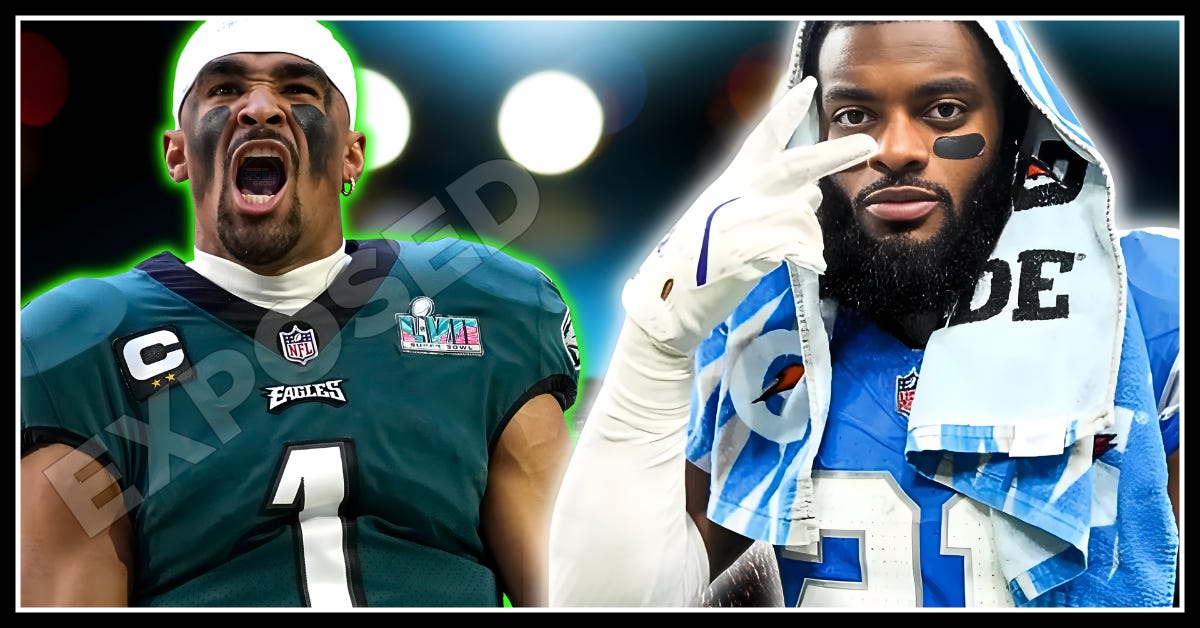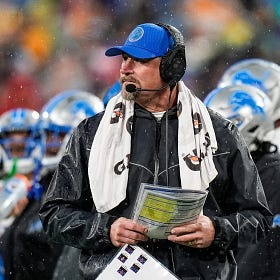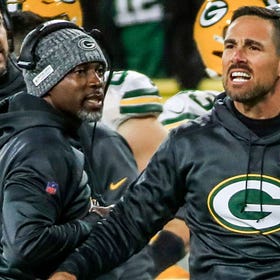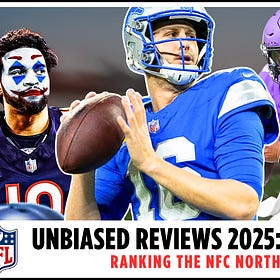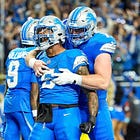NFL Week 11: Eagles Exposed - What The Detroit Lions Learned From MNF
Philadelphia may have escaped with a win on the scoreboard, but Week 10 exposed critical flaws in their offensive structure
What’s up, Lions Nation! Will Rock here with Rocked On Detroit Lions and Detroit Football Journal. Bringing you the most comprehensive breakdown of the Lions vs. Eagles matchup you’ll find anywhere. This weeks keys to the game submission will be three separate pieces.
The first piece dissects the Packers Vs Eagles MNF game, and how the Packers were able to limit the Eagles to 10 points. What worked and how the Lions can adopt a similar plan. The second installment covers the Lions offensive & defensive keys with analysis. Breaking down exactly how Detroit can expose Philadelphia—and how the Eagles plan to attack us. The third and final submission will be the Eagles offensive & defensive keys with analysis.
You Are Not SUBSCRIBED? Tap The Button RIGHT NOW - IT’S FREE!!
Week 10 Review: Eagles Vs Packers
What Did We Learn From The Packers?
Monday Night Football in Week 10 delivered a defensive slugfest between the Philadelphia Eagles and the Green Bay Packers, a game that ended 10-7 in favor of Philadelphia but revealed as much about the Eagles’ offensive vulnerabilities as it did about their defensive resilience.
For three quarters, neither team could find the end zone, and the first half ended in a rare 0-0 tie, the first such occurrence on Monday Night Football since 2009. The Packers’ defense executed a game plan that not only stifled the Eagles’ vaunted run game but also forced Philadelphia into a series of conservative, predictable play calls.
Philadelphia may have escaped with a win on the scoreboard, but Week 10 exposed critical flaws in their offensive structure—flaws the Detroit Lions must exploit in Week 11 if they plan to contain one of the NFL’s most dynamic offenses.
Eagles Offensive Line Struggles
Philadelphia’s offensive line, long considered one of the NFL’s most dominant units, was physically overwhelmed and schematically outmaneuvered by Green Bay’s front. The Packers controlled the line of scrimmage with a blend of speed, leverage, and tactical discipline that disrupted the Eagles’ offensive rhythm from the opening snap.
Operating primarily out of a 4-2-5 nickel front, Green Bay aligned both defensive tackles in shaded techniques over the A and B gaps, while their edge defenders played wide to set hard containment. Colby Wooden and Devonte Wyatt anchored the interior, consistently holding their ground against double teams and preventing vertical displacement.
Barkley Erased
This disruption at the point of attack stopped Saquon Barkley from reaching the second level and forced him to hesitate or bounce runs outside—where the Packers’ pursuit angles and edge discipline closed down cutback lanes. Barkley’s trademark explosiveness was erased.
Green Bay’s use of interior stunts and slants added another layer of disruption. By slanting tackles into adjacent gaps and looping edge defenders inside, the Packers created confusion for Philadelphia’s interior linemen, who struggled to pass off delayed rushers and pick up twists.
These schematic wrinkles not only limited Barkley to 60 yards on 22 carries (2.7 yards per attempt), but also generated five tackles for loss, resulting in -15 rushing yards. The Eagles’ ground game, typically a foundational strength, was neutralized by a front that prioritized gap integrity, leverage, and assignment execution over raw penetration.
Saquon Barkley Rushing Context:
2024 Season: 5.8 YPC Avg | 125 YDs P/G Avg (16 Games)
2025 Season: 3.9 YPC Avg | 64 YDs P/G Avg (9 Games)
Week 10: 2.7 YPC | Held under 60 YDs | Zero Explosive Runs 15+
Jalen Hurts Contained
Spy Discipline & Rush-Lane Integrity
Green Bay’s defensive plan leaned heavily on linebacker versatility and rush-lane discipline to contain Jalen Hurts. Hurts was neutralized in the area where he’s most dangerous — creating with his legs.
The Packers frequently deployed four linebackers. Quay Walker (OLB) shifted inside operating as the dedicated spy, shadowing Hurts on every snap and closing space when Hurts’ tried to escape redirecting him into help erasing improvisational plays.
Edgerrin Cooper (MLB) complimented Walker by triggering downhill fits, ensuring Hurts couldn’t break contain to the perimeter. Micah Parsons (OLB) lined up between Colby Wooden (DT) and Isaiah McDuffie (MLB) to maintained strict field side edge, while Wooden and Devonte Wyatt (DT) anchored the interior and Rashan Gary (DE) anchored the boundary edge. they created a layered containment shell that funneled Hurts into a controlled pocket.
The Packers’ edge rushers maintained strict rush-lane integrity, collapsing the pocket inward without overcommitting. This forced Hurts to retreat or step up into a controlled interior.
Jalen Hurts Neutered:
The Packers’ defensive game plan was built on one principle. Take away the ground game which involved Barkley and Jalen Hurts’ legs. The trick for Jalen Hurts was to force him to win from the pocket. It worked to near perfection.
Despite recording only six official pressures and zero sacks, Green Bay forced Hurts into uncomfortable throws by collapsing the pocket inward and eliminating his escape lanes. His average time to throw ballooned to 3.4 seconds with a 57.7% completion rate and no explosive plays through the air. A sign of hesitation and disrupted rhythm.
Jalen Hurts QB Context:
Scrambles: Spy discipline prevented Hurts from extending plays
Hurts’ Rushing: Limited to 27 yards on all rushing attempts
Passing: Forced into uncomfortable throws under pressure
15/26 - 183 YDs / 1TD | 7.0Avg | 57.7% Comp Rate
Criticals Count
Red Zone, Explosive Plays & 4th Down Failures
Philadelphia reached the red zone multiple times but couldn’t punch it in for touchdowns. They settled for field goals and failed to create explosive plays downfield. In the red zone, Green Bay shifted into tight man coverage with safety help, bracketing A.J. Brown and shading DeVonta Smith. Philadelphia went 0-for-2 on fourth downs and fumbled inside the 10. Hurts was forced to throw into condensed windows, and his receivers couldn’t separate.
Perhaps the most critical tactic was Green Bay’s situational patience. They didn’t blitz recklessly or chase sacks; they prioritized leverage and containment. Hurts faced only six pressures, but each was designed to funnel him into help. That’s why the Eagles failed to generate explosives—Hurts couldn’t extend plays, and Barkley couldn’t break free. The Packers forced Philadelphia to play left-handed, stripping away their two most dangerous weapons.
Key Stats:
Red zone efficiency: Fumble first trip inside the red zone turning the ball over, 0 touchdowns in multiple red zone trips on the day
Explosive plays: Zero plays of 20+ yards
Third down conversions: Struggled to convert critical third downs
0 For Fourth: 0-2 converting 4th down opportunities
What Went Wrong:
Green Bay’s defense tightened in the red zone, playing tight man coverage and preventing easy throws
A.J. Brown and DeVonta Smith were blanketed by Green Bay’s cornerbacks
Hurts couldn’t find open receivers in condensed space
Philadelphia’s play-calling became predictable in short-yardage situations
What Did Green Bay Do Well?
Green Bay’s defensive success against Philadelphia was built on discipline at every level. Linebackers Quay Walker and Edgerrin Cooper triggered downhill immediately after the defensive tackles occupied blockers, closing cutback lanes and eliminating the second-level seams Saquon Barkley thrives on. With the interior sealed, the Packers erased the foundation of the Eagles’ run game. The pocket consistently collapsed inward, forcing Hurts to hold the ball an average of 3.4 seconds before throwing, which led to late, off-platform decisions.
What Stood Out
Green Bay’s restraint to not over emphasize the need to get pressure or sack Hurts. The schematic emphasis on layered containment and interior tracking erased Hurts’ mobility advantage to extend plays and Barkley’s explosiveness.
The Packers didn’t blitz heavily or chase sacks. Instead, they emphasized leverage, discipline, and layered coverage. By collapsing the pocket without overcommitting, they forced Hurts to retreat or step up into traffic. The secondary reinforced this plan by rotating safeties late and bracketing A.J. Brown, preventing Hurts from finding quick outlets. Without vertical separation or scramble lanes, Hurts was left to throw into tight windows under duress.
The Packers may have lost the game, but they won the schematic battle. They exposed vulnerabilities in Philadelphia’s multi-layered offense and gave themselves a chance to win late
Green Bay showed that you don’t need gaudy sack totals to neutralize a mobile quarterback—you need discipline, patience, and a spy who never loses focus.
Can The Lions Execute A Similar Plan?
The answer is yes—but only if Detroit leans into discipline over aggression. Controlling the interior gaps with two-gap technique, holding ground against double teams, and preventing vertical displacement with leverage, patience, and layered containment is the key. The Lions have the personnel to replicate that blueprint, but every defender must stay true to their assignment. One lapse in gap integrity, one edge lost to over pursuit or sack chasing, and Saquon Barkley or Jalen Hurts can flip the game.
Defensive Line
Alim McNeill: Detroit’s disruptive 3-technique best used as a penetrator on stunts. He can crash the B-gap and loop into the A-gap to disrupt timing on inside zone. His quickness makes him ideal for tackle-end stunts to collapse the pocket. His ability to create negative plays is critical to preventing Barkley from reaching the second level.
DJ Reader: The anchor at 1-tech/nose. His 340-pound frame should stay disciplined in two-gap control. He’s the anchor, not the twister. His job is to occupy double teams and prevent vertical push, freeing linebackers to flow and force runs outside, where Detroit’s speed can pursue.
Tyleik Williams: Versatile and ready for an expanded role. His rotation keeps the front fresh and maintains pressure across four quarters. High effort player that finds a way to create a play.
Roy Lopez: A key rotational piece that has been playing incredibly well this season. His low pad level with speed and knock-back ability add interior disruption when Reader rests. Lopez can be used in the games on the defensive line.
Together, this rotation must replicate the gap control Wyatt and Wooden displayed for Green Bay—holding ground against double teams and eliminating vertical push.
Edge Defenders
Aidan Hutchinson: Can execute long-loop stunts (end-tackle twists) where he crashes inside and loops around McNeill. His motor and length make him dangerous when crossing face into the interior. Aidan must maintain his gap control caging the pocket with a low arc off the edge. Playing to Hurts drop level is vital. If he gets too deep or wide Hurts will take the lane and gash the defense for explosive runs and find the open receiver for big explosives downfield.
Al-Quadin Muhammad: Should play more straight-up contain. He’s the edge setter who prevents Hurts from breaking outside. Must set hard contain and resist the temptation to crash inside with over-pursuit.
Tyler Lacy / Tyrus Wheat: Rotational edge players who can run short stunts inside to keep guards guessing, but their primary role is maintaining fresh contain.
Linebackers & Secondary
Jack Campbell: He should not stunt or blitz often; with his sideline-to-sideline range and instincts, Jack is the ideal candidate to mirror Quay Walker’s role as the dedicated spy on Jalen Hurts and close scramble lanes.
Alex Anzalone: Occasionally blitz off the edge or green-dog (trigger blitz if Barkley stays in to block). Expect Anzalone to rotate into spy responsibilities when the Lions disguise the spy. Anzalone provides that veteran awareness and discipline which makes him effective in timing delayed pressures.
Derrick Barnes: Useful in edge blitzes and adds versatility with his ability to cover tight ends and close down the edge on Barkley’s perimeter runs. He can crash outside when Hurts rolls, forcing him back inside toward Campbell.
Detroit’s secondary is thin with DJ Reed & Terrion Arnold out, but the scheme is replicable with Amik Robertson, Rock Ya Sin and the Legion of “Whom.” Brian Branch will need to play his best game as a robber, with Arthur Maulet in the slot and either Thomas Harper or Avonte Maddox helping Branch out. No matter who is in the scheme is the same, bracket Brown, shade Smith, and force Hurts to rely on Dallas Goedert underneath. The Lions must accept short completions while eliminating explosives.
The goal isn’t sacks—it’s leverage and control. Keep Barkley from getting to the second level, and force Hurts to beat you from the pocket.
Kelvin Sheppard’s Biggest Test
The NFL is a copycat league, and the Lions have the answers to the test right in front of them. Kelvin Sheppard must balance his aggressive coaching style with a more cerebral, calculated approach. If he leans too heavily into aggression—selling out on the edge and chasing sacks—Detroit risks repeating Aaron Glenn’s mistake from last year’s playoff loss to Washington, where over-pursuit and aggressive blitzing opened lanes for explosive plays.
The clear path to victory is discipline: a linebacker spy paired with containment principles up front. Green Bay proved this works, holding Philadelphia to its lowest scoring output since November 28th, 2021. Jalen Hurts was the starting QB vs Giants - losing 7-13.
The Eagles did in fact lose 27-10 on January 7th, 2024. However, that game doesn’t really count. The Eagles rested a majority of starters for the week 18 closure to the regular season against the Giants.
Last Time The Eagles Scored 10 Points Or Less:
January 7th, 2024: Hurts & Mariota Starting QB vs Giants - losing 10-27.
January 1st, 2023: Gardner Minshew starting QB vs Saints - loss 10-20
November 28th, 2021: Jalen Hurts starting QB vs Giants - loss 7-13
BONUS:
Not everything was scheme related, so before the cheesehead fans gloat to the point of cheese curds oozing from their facial orifices. This is not an uncommon trait for a running back to regress after a historic season.
Saquon Barkley’s season extended a full month beyond the typical workload for most running backs — a taxing stretch that history suggests can take a toll the following season. Similar usage has led to sharp declines for elite backs in the past.
After rushing for 2,006 yards in 2009, Chris Johnson saw his total fall to 1,364 the following year. Adrian Peterson followed his 2,097-yard MVP campaign in 2012 with just 1,266 yards in 2013. Finally, even the GOAT Barry Sanders followed a historic 2,053-yard MVP campaign in 1997 with 1,491 yards in 1998. However, Sanders bounce back was much more impressive. Sanders averaged 1,468 yards per season not including 1997, finishing above average. Chris Johnson & Adrian Peterson averaged far less.
The pattern is clear: extended mileage often invites regression or injury, even for the league’s most durable stars.
Don’t be fooled, Barkley is as electric as they come, he can break out at any moment and hurt you if you soften even a little bit in maintaining your assignment, not staying true to the details.
Join The Detroit Football Journal Daily Podcasts Below
LATEST STORIES
Deep Dive: Coaching Strategy Breakdown for Matt LaFleur Ahead of Week 1
Matt LaFleur enters the 2025 season with a reputation for precision and poise. While Dan Campbell commands headlines with his aggressive fourth-down calls, LaFleur operates with a quieter intensity—his playbook built on motion, misdirection, and rhythm. Since taking over in Green Bay, he’s led the Packers to multiple playoff appearances and crafted one of the league’s most efficient offenses, even amid roster turnover and quarterback transitions.
The NFC North's Top Ranked Quarterback Is Once Again Jared Goff - It's Not Close
Every season Rocked On Sports Media performs an unbiased review for all positional groups within the NFC North. Grading, analyzing and ranking each positional group from one (1) being the best, and four (4) being the worst.



